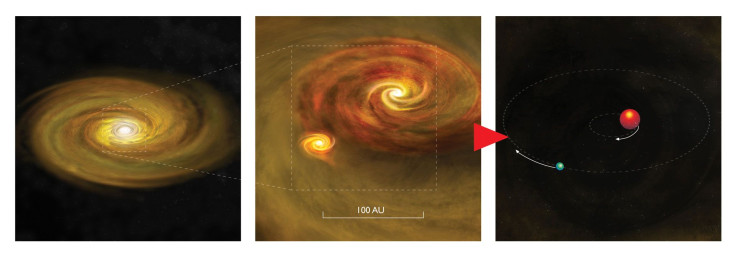New Discovery Could Explain The Mystery Of Binary Star Formation: Study

Scientists have discovered previously unseen binary companions to a pair of protostars -- young stars that are in the early stages of formation before reaching the main sequence stage -- lending strong support for one of the competing explanations for how binary-star systems form.
According to the scientists, who used the Karl G. Jansky Very Large Array, or VLA, a radio astronomy observatory located on the Plains of San Agustin, about 50 miles west of Socorro, N.M., it is known that about half of all Sun-like stars are members of double or multiple-star systems. However, theories about how such systems are formed have so far been inconclusive.
“The only way to resolve the debate is to observe very young stellar systems and catch them in the act of formation,” John Tobin of the National Radio Astronomy Observatory, or NRAO, in Charlottesville, Va., said in a statement. “That's what we've done with the stars we observed, and we got valuable new clues from them.”
The scientists said that the new clues support the idea that double-star systems form when a disk of gas and dust spins around one young star's fragments, forming another new star in orbit with the first. According to the scientists, young stars that are still gathering matter from their surroundings form such disks of gas and dust, along with jet-like outflows rapidly propelling material in narrow beams perpendicular to the disks.
Tobin and his team of astronomers studied gas-covered young stars approximately 1,000 light years from Earth and found that two such stars had previously unseen companions in the plane where their disks would be expected, perpendicular to the direction of the outflows from the systems. One of the systems also had a disk surrounding both young stars.
“This fits the theoretical model of companions forming from fragmentation in the disk,” Tobin said. “This configuration would not be required by alternative explanations.”
The scientists said that the new discovery adds to a growing body of evidence that supports the disk-fragmentation idea. In 2006, a different VLA observing team found an orbiting pair of young stars, each of which was surrounded by a disk of material. The two disks were aligned with each other in the same plane.
“Our new findings, combined with the earlier data, make disk fragmentation the strongest explanation for how close multiple star systems are formed,” Leslie Looney of NRAO said in the statement.
The astronomers discovered the young stars in 2012 with the VLA and the Combined Array for Research in Millimeter-wave Astronomy in California. The scientists recently published their findings in the Astrophysical Journal.
© Copyright IBTimes 2025. All rights reserved.






















